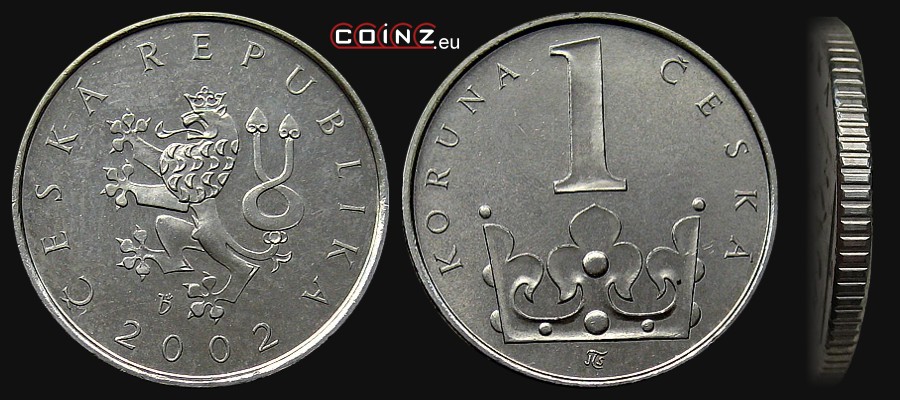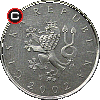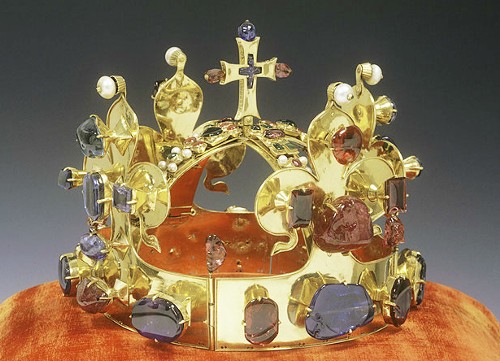1 koruna Czechia (from 1993)


| diameter: | weight: | thickness: | alloy: |
| 20.0 mm | 3.6 g | 1.85 mm | Fe Ni-plated |
obverse:
in the centre the lion - Czech Coat of Arms; along the top edge: ČESKÁ REPUBLIKA (Czechia); along the bottom edge year of issue
reverse:
above the centre large face value: 1 (koruna); below simplified crown of Saint Venceslas; along the top edge: KORUNA ČESKÁ (Czech koruna)
edge:
reeded (80 serrations)
issue date:
30 VI 1993
withdrawal date:
in circulation
designer:
Jarmila Truhlíková-Spěváková (stylised initials JTS on the bottom of the reverse)
mint:


Bižuterie Jablonec a.s. (Jewellery Jablonec JSC) (name in years 1993-1995);
Bižuterie Česká Mincovna a.s. (Jewellery Czech Mint JSC) (name in years 1995-2004);
Česká Mincovna a.s. (The Czech Mint JSC) (name after 2004), Jablonec nad Nisou (coins from 1994 till now)
(relevant mint mark at lion's paws on the obverse)

mintage:
| 1993 | 102 429 343 |  |
50 000 in annual boxed sets |
| 1994 | 52 162 680 |  |
30 000 in annual boxed sets |
| 1995 | 40 668 280 |  |
22 400 in annual boxed sets |
| 1996 | 35 344 913 |  |
26 040 in annual boxed sets |
| 1997 | 15 055 501 |  |
15 000 in annual boxed sets |
| 1998 | 25 000 |  |
15 000 in annual boxed sets |
| 1999 | 24 914 |  |
17 000 in annual boxed sets |
| 2000 | 9 696 000 |  |
23 000 in annual boxed sets |
| 2001 | 21 811 050 |  |
11 500 in annual boxed sets |
| 2002 | 26 244 666 |  |
17 000 in annual boxed sets |
| 2003 | 15 912 000 |  |
22 000 in annual boxed sets |
| 2004 | 20 995 940 |  |
30 500 in annual boxed sets |
| 2005 | 14 000 |  |
22 000 in annual boxed sets |
| 2006 | 27 097 500 |  |
25 000 in annual boxed sets |
| 2007 | 14 170 500 |  |
21 000 in annual boxed sets |
| 2008 | 29 617 000 |  |
16 000 in annual boxed sets |
| 2009 | 38 367 400 |  |
10 000 in annual boxed sets |
| 2010 | 15 004 600 |  |
10 000 in annual boxed sets |
| 2011 | 22 068 150 |  |
15 000 in annual boxed sets |
| 2012 | 19 976 503 |  |
26 500 in annual boxed sets |
| 2013 | 19 962 603 |  |
20 000 in annual boxed sets |
| 2014 | 12 120 713 |  |
23 500 in annual boxed sets |
| 2015 | 18 356 633 |  |
14 000 in annual boxed sets |
varieties:
1995 - a) digit 5 in year of issue rounded with a long "roof" or b) tall with short "roof" (at least 22.400 pieces were produced);
1996 - a) digits of year of issue widely spaced and digit 1 without any "roof" or b) digits narrowly spaced and digit 1 with a clear "roof" (at least 26.040 pieces were produced); note various alligments of the mint mark;

2000 - three varieties of the designer's initials: a) in letter T the "leg" and "roof" separately, b) letter T complete and letter J short, c) letter T complete and letter J tall;
2001, 2002, 2003 - each has two varieties of designer's initials: a) in letter T "leg" and "roof" separately, b) letter T complete
1996 - a) digits of year of issue widely spaced and digit 1 without any "roof" or b) digits narrowly spaced and digit 1 with a clear "roof" (at least 26.040 pieces were produced); note various alligments of the mint mark;

2000 - three varieties of the designer's initials: a) in letter T the "leg" and "roof" separately, b) letter T complete and letter J short, c) letter T complete and letter J tall;
2001, 2002, 2003 - each has two varieties of designer's initials: a) in letter T "leg" and "roof" separately, b) letter T complete
interesting facts:
The crown of Saint Wenceslas was created around the year 1346 by the order of the future King Charles IV of Bohemia. Just over two-kilogramme jewel was made of gold 900 and decorated with precious stones and later pearls. The contemporary Pope Clement VI issued a papal bull, in which he mentioned that the crown is for the head of St. Wenceslas, deceased 400 years earlier, whose tomb was in the cathedral of St. Vitus at Prague Castle. Charles IV used the jewel, however, for his own coronation in 1347. Starting from this year, the crown became the insignia of royal power and national relic of the Czechs. The last time it was used at the coronation of the Austrian Emperor Ferdinand I of Habsburg in 1836. Since then, it has been kept in a secret place in the cathedral and has been very rarely exposed to public. In the time of the Czechia it is presented every five years during the inauguration of presidents.

photo: Jaroslav Andrei Šumbera Hyršl
The lion has been a symbol of the Czechs for nearly 800 years. It derives from the medieval Premyslid dynasty. The peaceful dissolution of Czechoslovakia in 1993 and the rise of the Czechia re-established the dynastic lion to the national Coat of Arms. According to the rules of the heraldic art every piece of the Arms should be presented in a way that expresses the militancy and prowess. An intensive parliamentary debate was concerning especially the lion's male attribute. The heraldic art prevailed and the lion took the pose of full combat readiness.

photo: Jaroslav Andrei Šumbera Hyršl
The lion has been a symbol of the Czechs for nearly 800 years. It derives from the medieval Premyslid dynasty. The peaceful dissolution of Czechoslovakia in 1993 and the rise of the Czechia re-established the dynastic lion to the national Coat of Arms. According to the rules of the heraldic art every piece of the Arms should be presented in a way that expresses the militancy and prowess. An intensive parliamentary debate was concerning especially the lion's male attribute. The heraldic art prevailed and the lion took the pose of full combat readiness.
last update: 17 III 2016
coins catalogue :: katalog monet :: münzkatalog :: catalogue de monnaies :: catálogo de monedas :: catalogo monete :: каталог монет :: κέρματα κατάλογος :: COINZ.eu
© 2010-2025 :: Adam Kubicki :: COINZ.eu :: All rights reserved.


